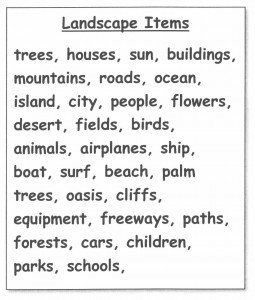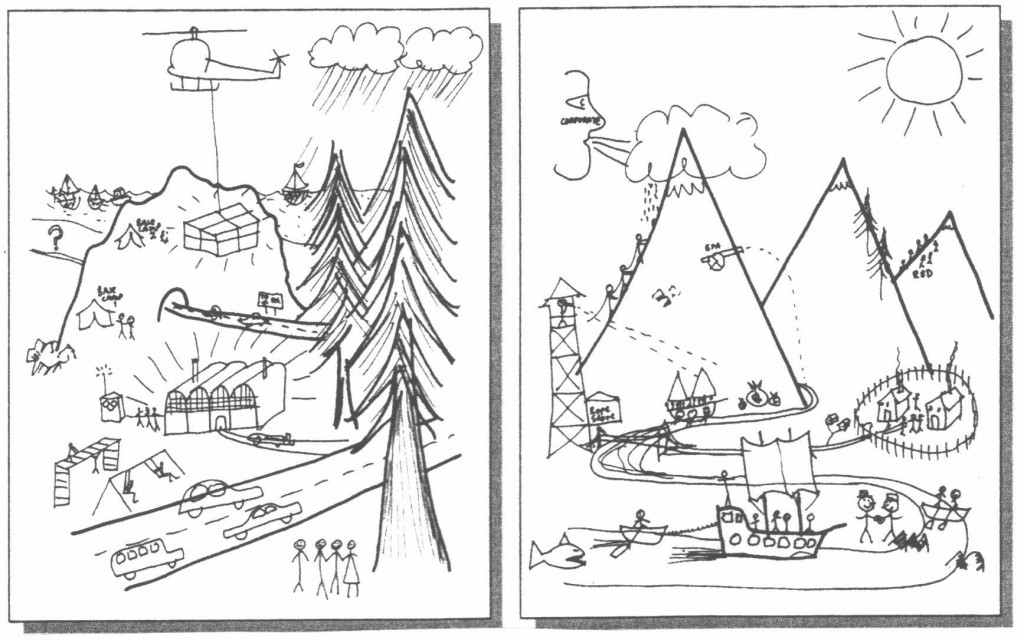The Landscape Metaphor ®
It’s impossible to put most of life’s experiences into words. At work, it’s fairly straightforward to verbally describe operational issues — projects, the finances, the structure, and hardware. But when it comes to our personal lives, what really counts — our relationships, hopes and fears, trust or lack of, apprehensions, being heard or appreciated or ignored, i.e. the immediate, concrete, ordinary experience of being an organizational member — words just don’t cut it.
For thousands of years people have used music, dance, art, and forms of literature such as metaphor and poetry, and more recently film, to convey human experience. Of course, none of them get to the core of it, but they’re the best tools we have.
To help people describe the subtle complexity of the work culture, Royal Foote, Ph.D. at Meridian Group, developed a tool that quickly records and communicates many difficult-to-describe and often too-scary-to-talk-about-directly qualities of the work culture.
What I describe here may sound to some of you a little simplistic or even childlike. But I can assure you it works spectacularly. I have used it dozens of times to great effect. Many managers look back years later to these drawings, warmly and vividly recalling the issues the metaphor helped put on the table for discussion, often for resolution. Years later managers recall the relief they felt, at last, getting into the open deep-seated, chronic, frustrating issues around relationships, authority, and communications.
What to Do
Because it’s so strange and unconventional, the group has to be warmed up to the task. If you are the group’s leader/facilitator you tell them the group will divide into groups of 4 or 5 people. Each small group will draw one picture that includes all the elements that individual members feel are important at work. They all have 40 minutes to do the drawing and it can only use items that you find in landscapes — any kind of landscapes — but not words.
A s the facilitator, you now ask the group to name things they might see in a landscape. Write down the words they say on a board or pad for all to see. They might start with trees or roads or houses or people. If the group gets into one track, widen their view with a question such as “How about in the tropics?” Or “What other kinds of landscapes do we have here in America?”
s the facilitator, you now ask the group to name things they might see in a landscape. Write down the words they say on a board or pad for all to see. They might start with trees or roads or houses or people. If the group gets into one track, widen their view with a question such as “How about in the tropics?” Or “What other kinds of landscapes do we have here in America?”
When the list has 20 to 40 items on it and seems to cover a wide range of landscapes, say, “Now I would like you to take 40 minutes for each group to draw a picture describing how you experience . . . . . (name of the organization) using the elements from landscapes as a metaphor. No words. We are not looking for artistry. The picture should include what is important to each of you. You each have many important experiences that you can describe this way. To start you might discuss and agree on some general picture that will allow everything to be included. Everyone should contribute. You can all draw or not, but everyone must contribute and participate. The drawing must include everything you think is important. When we get back together in 40 minutes, I’d like each group to describe how it decided what to do and then what the drawing means. Any questions? . . . . . . . . . . . . Enjoy yourselves.”
Be Patient
There’s always confusion at the beginning. It’s a strange exercise and some people may be embarrassed: “Adults don’t do things like this.” But it doesn’t take long for each group to get into the swing of it. If you have a particularly small group of leaders or managers, say six or seven, you can still make two groups. It’s important that each group work independently so they don’t see or hear what another group is doing.
People usually get very creative, drawing forests with tall trees, race cars, mountain climbing, warships at sea, battles, playgrounds, money bags, battles. These describe important parts of the work culture conveying meanings that could not be described so clearly, simply and richly by any other means.
When you return, ask each group to describe the process they went through in deciding what to do, then what the drawing is and what it means. Usually, each group will have one person speak for the group, but it’s a good idea to invite each other person in that group to add anything he or she feels was missed in the description.
Drawing a landscape metaphor is an excellent beginning for a retreat or a little way into the culture development process. The drawings reveal important areas for discussion that might otherwise remain under the table. Group members typically want to take these drawings back to the office and pin them in a very visible place. It’s a memorable experience. Two examples.
cc 213 — © Barry Phegan, Ph.D.
